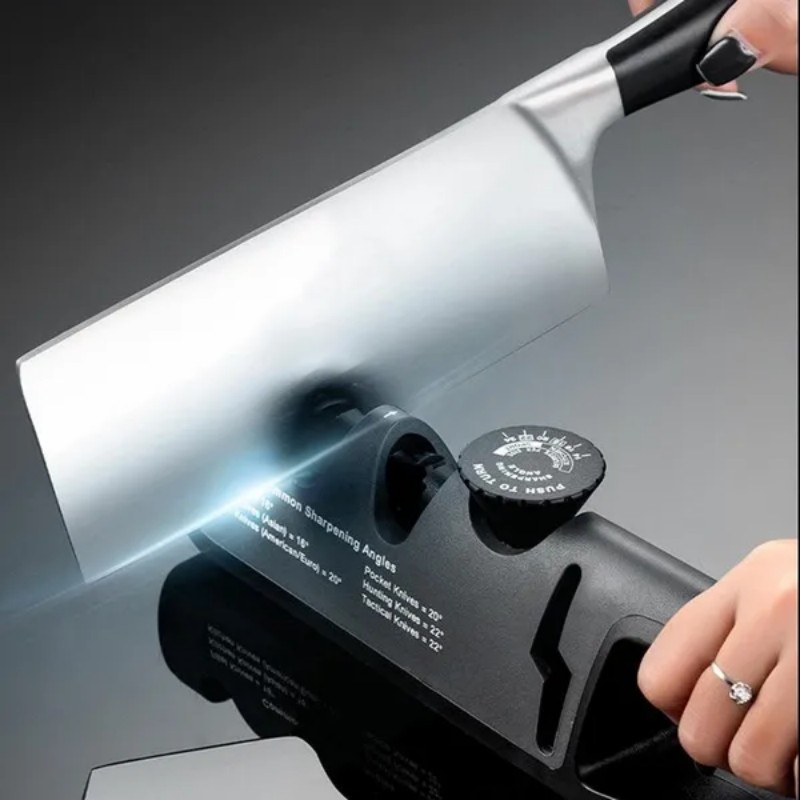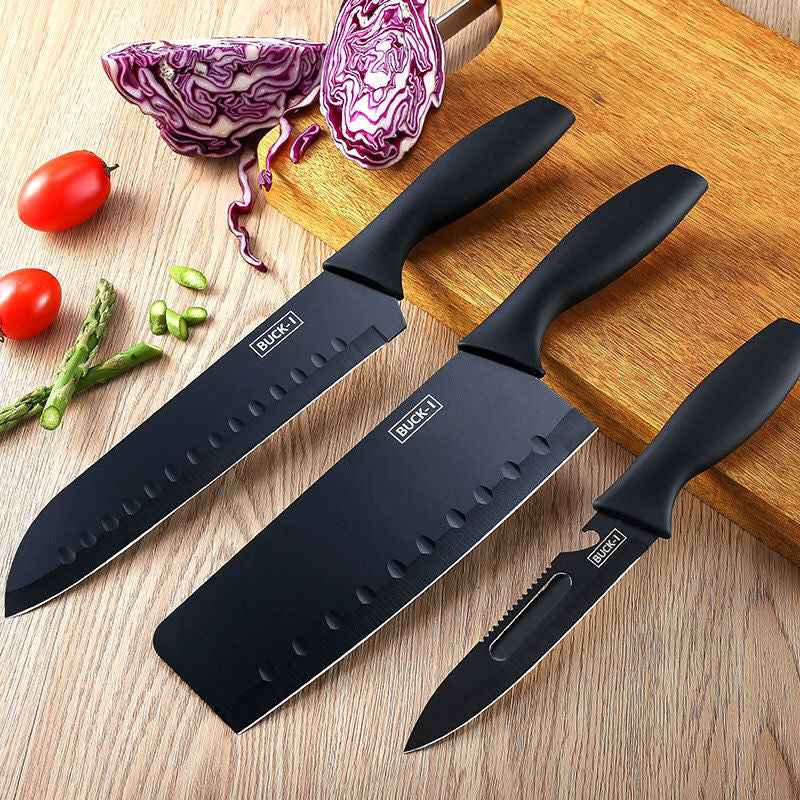Introduction
When it comes to maintaining your kitchen knives, one of the most crucial aspects is understanding the proper sharpening angle. Sharpening your knives at the correct angle not only helps maintain their performance but also ensures longevity. While it may seem like a minor detail, the angle at which you sharpen your knife can have a significant impact on how well it performs and how often it needs to be sharpened. This comprehensive guide will break down everything you need to know about choosing the right sharpening angle for your kitchen knives.
Understanding Knife Sharpening Basics
When it comes to keeping kitchen knives in top shape, the sharpening angle is pivotal. It is the angle at which the knife’s edge meets the sharpening tool. Selecting the correct angle influences how the knife performs during slicing and dicing. So, what angle to sharpen kitchen knives?

The Role of Sharpening Angles in Knife Maintenance
Sharpening angles directly affect a knife’s sharpness and its ability to cut efficiently. A proper angle ensures a razor-sharp edge that makes cooking tasks easier. Remember, an accurate sharpening angle reduces blade wear, making it last longer.
Choosing what angle to sharpen kitchen knives at can be tricky. Deciding on the right angle depends on knife type, intended use, and personal preference. Proper maintenance with the right angle keeps edges sharp and extends the life of the knife.
Hardness vs. Toughness in Knife Materials
Hardness refers to a knife’s ability to resist deformation. Toughness, meanwhile, stands for its ability to resist chipping and breaking. Both characteristics are essential for a knife’s performance.
Knife material plays a role in determining the angle for sharpening. Tough materials might need steeper angles to maintain durability. Harder materials can be sharpened to finer angles for precision cutting.
In summary, picking the right sharpening angle is crucial for knife maintenance. It keeps the blade’s edge sharp, helping it perform better and last longer. Hardness and toughness factors influence the choice of sharpening angle.
Ideal Sharpening Angles for Different Uses
Let’s explore the best angles to sharpen kitchen knives for varied tasks.
Sharpening Angles for Precision Cutting: Under 10 Degree Angles
For delicate cutting, angles under 10 degrees are ideal. This fine edge suits tasks needing precision, like slicing soft cheese or peeling fruits.
Balanced Sharpness and Durability: 10 to 15 Degree Angles
Angles between 10 to 15 degrees offer a balance. They work well for slicing meats or chopping herbs.
Common Angles for Kitchen Knives: 15 to 17 Degree Angles
Most kitchen knives do best with 15 to 17 degree angles. They are sharp enough for efficient cutting and durable for frequent use.
Sharpening for Versatility: 17 to 22 Degree Angles
Angles from 17 to 22 degrees are versatile. They’re suitable for kitchen knives used in various cutting tasks.
Maximizing Durability: 22 to 30 Degree Angles
For knives that face heavy use, angles between 22 to 30 degrees are recommended. They offer more durability, with a slightly less sharp edge.
Outlines for Heavy-Duty Tools: Over 30 Degree Angles
Angles over 30 degrees are for heavy-duty tools. They stay sharp longer under hard use but are less sharp overall.

Selecting Angles Based on Knife Type and Use
When sharpening kitchen knives, consider the knife type and its intended use.
Deciding Between Western and Asian Knife Angles
Western-style knives usually feature angles between 17 to 22 degrees. They are durable for varied uses.
Asian-style knives often have sharper angles, around 15 to 17 degrees, for precision cutting.
Knife Brand Specifics and Recommended Angles
Brands like Wusthof favor a 20-degree sharpening angle. Shun typically opts for a 15-degree angle. Follow brand recommendations for best results.
The Impact of Steel Type on Sharpening Angles
Hard steels hold finer angles, allowing for sharper edges. Softer steels may need steeper angles for edge durability. Consider the steel type when selecting your angle.
Sharpening Techniques for Different Angles
Achieving the perfect sharpness for kitchen knives demands mastery of sharpening techniques. It’s not just about knowing what angle to sharpen kitchen knives at, but also about how you get there.
Tools and Techniques for Achieving Desired Angles
The right tools make all the difference when sharpening knives. Here are a few essentials:
- Whetstones offer great control for hand sharpening.
- Honing rods realign knife edges without removing much material.
- Electric sharpeners provide speed and convenience.
Select the suitable method based on knife type and sharpening proficiency.
Using precise movements is key. Glide the knife’s edge across the stone at the correct angle. Hold the blade firmly and consistently. Apply even pressure from blade heel to tip.

Maintaining Consistency in Angle Throughout Sharpening
Consistency is vital for a sharp and durable edge. Here are some tips:
- Use a sharpening guide for maintaining a steady angle.
- Mark the edge with a marker before sharpening. This acts as a visual guide.
- Check your angle frequently. Adjust as needed to stay on track.
Remember, practice improves your technique. Over time, your muscle memory will help in maintaining the angle.
Advantages of Using Sharpening Guides and Systems
Why consider a guide or system? Here are the benefits:
- Sharpening guides eliminate guesswork. They ensure the angle remains consistent.
- Systems like the angle guide clip-on can speed up learning.
- Many systems are adjustable, catering to different knives and angles.
These aids help beginners gain confidence. They also ensure seasoned chefs achieve the precision they desire.
The Balance Between Sharpness and Edge Integrity
Finding the right balance is essential for knife care.
Trade-offs Between Edge Sharpness and Durability
Sharpening angles affect both the sharpness and durability of a knife’s edge.
- Sharp, fine angles make knives precise but fragile.
- Steeper angles provide robust, long-lasting edges, though less sharp.
Choosing depends on knife usage and user preferences.
The Intersection of Angle, Material, and Edge Longevity
Different materials influence edge longevity at various angles.
- Hard steels retain sharper angles longer but need careful handling.
- Softer steels benefit from steeper angles, offering more durability.
Selecting the appropriate angle not only sharpens but also maintains the knife’s life span.
Tips for Extending the Life of Your Sharpened Edge
Maintaining a knife’s edge requires specific care measures.
- Regular honing realigns the edge without removing too much material.
- Avoid cutting on hard surfaces to prevent premature dullness.
- Proper storage, using knife blocks or sheaths, protects the edge.
Implement these practices to prolong sharpness and minimize frequent sharpening needs.
Concluding Thoughts on Sharpening Angles
Selecting the proper angle to sharpen kitchen knives is vital. It affects performance, edge longevity, and safety. Understanding sharpening basics and recognizing the best angles for different uses ensures optimal knife maintenance.
Summarizing Key Points for Knife Sharpening Angles
- Precision Cutting: Angles under 10 degrees are best for delicate tasks.
- Balanced Sharpness and Durability: Opt for 10 to 15 degrees for routine kitchen tasks.
- Common Kitchen Knife Angles: 15 to 17 degrees are ideal for most kitchen knives.
- Versatility: Use 17 to 22 degrees for different types of cuts.
- Max Durability: Angles between 22 to 30 degrees are most durable.
- Heavy-Duty Tools: Over 30 degrees is best for tough usage.
Choosing the right angle is influenced by the knife’s type, intended use, and steel hardness.
Additional Resources for Effective Knife Maintenance
For more detailed guidance, consider consulting knife manufacturers’ recommendations and professional sharpening tutorials. Online forums and videos often provide practical sharpening demos and tips. Regularly refer to trusted knife maintenance resources to enhance your skills and ensure your knives remain in top condition.

